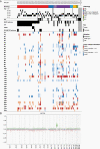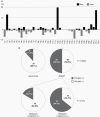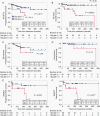12p gain is predominantly observed in non-germinomatous germ cell tumors and identifies an unfavorable subgroup of central nervous system germ cell tumors
- PMID: 34698864
- PMCID: PMC9071297
- DOI: 10.1093/neuonc/noab246
12p gain is predominantly observed in non-germinomatous germ cell tumors and identifies an unfavorable subgroup of central nervous system germ cell tumors
Abstract
Background: Central nervous system (CNS) germ cell tumors (GCTs) are neoplasms predominantly arising in pediatric and young adult populations. While germinomas generally respond to chemotherapy and radiation, non-germinomatous GCTs (NGGCTs) require more intensive treatment. This study aimed to determine whether 12p gain could predict the prognosis of CNS GCTs.
Methods: Eighty-two CNS GCTs were included in this study. The 12p gain was defined by an additional 12p in the background of potential polyploidy or polysomy. Cases were analyzed using an Illumina methylation 450K array for copy number investigations and validated by fluorescence in situ hybridization (FISH).
Results: A 12p gain was found in 25-out-of-82 cases (30%) and was more frequent in NGGCTs (12% of germinoma cases and 50% of NGGCT cases), particularly in cases with malignant components, such as immature teratoma, yolk sac tumor, choriocarcinoma, and embryonal carcinoma. 12p gain and KIT mutation were mutually exclusive events. The presence of 12p gain correlated with shorter progression-free (PFS) and overall survival (OS) (10-year OS: 59% vs. 94%, with and without 12p gain, respectively, P = 0.0002), even with histology and tumor markers incorporated in the multivariate analysis. Among NGGCTs, 12p gain still had prognostic significance for PFS and OS (10-year OS: 47% vs. 90%, respectively, P = 0.02). The 12p copy number status was shared among histological components in mixed GCTs.
Conclusions: 12p gain may predict the presence of malignant components of NGGCTs, and poor prognosis of the patients. It may be associated with early tumorigenesis of CNS GCT.
Keywords: 12p gain; DNA methylation; FISH; central nervous system germ cell tumor; copy number alteration.
© The Author(s) 2021. Published by Oxford University Press on behalf of the Society for Neuro-Oncology. All rights reserved. For permissions, please e-mail: journals.permissions@oup.com.
Figures




Similar articles
-
Distinct patterns of copy number alterations may predict poor outcome in central nervous system germ cell tumors.Sci Rep. 2023 Sep 21;13(1):15760. doi: 10.1038/s41598-023-42842-3. Sci Rep. 2023. PMID: 37735187 Free PMC article.
-
PD-L1 and PD-1 expression in pediatric central nervous system germ cell tumors.Mod Pathol. 2022 Dec;35(12):1770-1774. doi: 10.1038/s41379-022-01142-3. Epub 2022 Sep 3. Mod Pathol. 2022. PMID: 36057740
-
Prognostic implications of distinctive imaging characteristics in primary intracranial germ cell tumors: A retrospective analysis.J Formos Med Assoc. 2025 May;124(5):439-445. doi: 10.1016/j.jfma.2024.05.016. Epub 2024 May 30. J Formos Med Assoc. 2025. PMID: 38821737
-
Multi-institutional analysis of central nervous system germ cell tumors in patients with Down syndrome.Pediatr Blood Cancer. 2022 Oct;69(10):e29830. doi: 10.1002/pbc.29830. Epub 2022 Jun 10. Pediatr Blood Cancer. 2022. PMID: 35686831 Review.
-
Biomarkers for risk-based treatment modifications for CNS germ cell tumors: Updates on biological underpinnings, clinical trials, and future directions.Front Oncol. 2022 Sep 5;12:982608. doi: 10.3389/fonc.2022.982608. eCollection 2022. Front Oncol. 2022. PMID: 36132131 Free PMC article. Review.
Cited by
-
Local recurrence of submucosal invasive colorectal cancer after endoscopic submucosal dissection revealed by copy number variation.DEN Open. 2023 Jan 31;3(1):e208. doi: 10.1002/deo2.208. eCollection 2023 Apr. DEN Open. 2023. PMID: 36742280 Free PMC article.
-
Distinct patterns of copy number alterations may predict poor outcome in central nervous system germ cell tumors.Sci Rep. 2023 Sep 21;13(1):15760. doi: 10.1038/s41598-023-42842-3. Sci Rep. 2023. PMID: 37735187 Free PMC article.
-
Successful Multimodal Treatment of Intracranial Growing Teratoma Syndrome with Malignant Features.Curr Oncol. 2024 Mar 29;31(4):1831-1838. doi: 10.3390/curroncol31040138. Curr Oncol. 2024. PMID: 38668041 Free PMC article.
-
Nasal immature teratoma in an elderly patient: Clinicopathological and epigenetic analogies with central nervous system counterparts, alongside genomic divergences.Neuropathology. 2025 Apr;45(2):100-108. doi: 10.1111/neup.13008. Epub 2024 Oct 2. Neuropathology. 2025. PMID: 39359021 Free PMC article.
-
Is Human Chorionic Gonadotropin a Reliable Marker for Testicular Germ Cell Tumor? New Perspectives for a More Accurate Diagnosis.Cancers (Basel). 2025 Jul 21;17(14):2409. doi: 10.3390/cancers17142409. Cancers (Basel). 2025. PMID: 40723290 Free PMC article. Review.
References
-
- Louis D, Ohgaki H, Wiestler O, Cavenee W. WHO classification of tumours of the central nervous system (Revised 4th Edition). Lyon: International Agency for Research on Cancer (IARC); 2016.
-
- Takami H, Fukushima S, Aoki K, et al. ; Intracranial Germ Cell Tumor Genome Analysis Consortium (the iGCT Consortium) . Intratumoural immune cell landscape in germinoma reveals multipotent lineages and exhibits prognostic significance. Neuropathol Appl Neurobiol. 2020; 46(2):111–124. - PubMed
-
- Makino K, Nakamura H, Yano S, Kuratsu J; Kumamoto Brain Tumor Research Group . Incidence of primary central nervous system germ cell tumors in childhood: a regional survey in Kumamoto prefecture in southern Japan. Pediatr Neurosurg. 2013; 49(3):155–158. - PubMed
-
- Kang J-M, Ha J, Hong EK, et al. A nationwide, population-based epidemiologic study of childhood brain tumors in Korea, 2005–2014: a comparison with United States data. Cancer Epidemiol Biomarkers Prev. 2019; 28(2):409–416. - PubMed
Publication types
MeSH terms
Supplementary concepts
LinkOut - more resources
Full Text Sources
Medical

